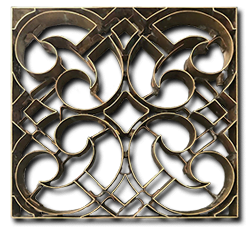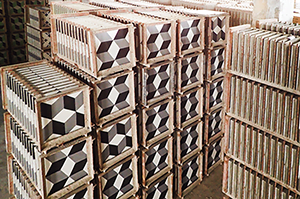A little about our workshop and the encaustic tile history
We are manufacturers.
The structure of the tile, of 1,6cm thick, is divided in 3 parts:
The thinnest part is the decorated surface of 2 mm thick, and is composed of a mixture of white cement, marble, sand and mineral pigments. The solid pigments are mixed with water, giving way to a dense solution which is poured in to the color separator mold, to form the desired design.
The second layer, the “brassatage”, with the same thickness as the pigmented layer, is composed of a mixture of grey cement and sand; it´s function is to absorb the excess water from the outer layer. The third and last layer, the thickness of the tile, is composed by solid cement with the slightest proportion of sand, it’s porosity eases the adherence to the floor during during placement and it’s solidness guarantees the longevity of the tile. They are also ideal for wall placement.

Their texture and craftsmanship can dress any wall in a unique way, combining colors and design.
How encaustic tiles are made.
1.
We start by talking to our clients in order to get a clear picture of what they’re looking to create. For those who have a clear idea of the mosaic they want, we then move on to step 2.
For those seeking advice, we offer free assessment ranging from the interior design of the space as a whole, to the last touches of choosing the exact colors they need for their encaustic tiles.
2.
The mold is then made if the design needed isn’t in our catalogue; this can take up to a week. This is handmade by an artisan blacksmith.

3.
Once the mold is made, we move on to the manufacturing process.
We start off by doing some try-out tiles to check that the mold is in perfect shape, then we make the correct pigments,
these are hand-mixed so once we measure the quantities needed of each color we proceed to manufacturing the second try-out tile.
We can send pictures at this stage if the client requests it to make sure colors are perfect.
4.
At this point it’s time to make the whole mosaic.
5.
The mosaic will now need to naturally set and dry, this depends on the weather, but usually takes from 3-5 weeks.

6.
It is then packaged in boxes and palletized. We wrap the pallet in plastic and it’s ready to be sent or picked up.
Have a look at how we make our encaustic tiles.
Our Artisans come from a long lineage of encaustic tile manufacturers.
This is important for various reasons, but to name a few:
You can learn more about the encaustic tile history in our home page or in Wikipedia.

